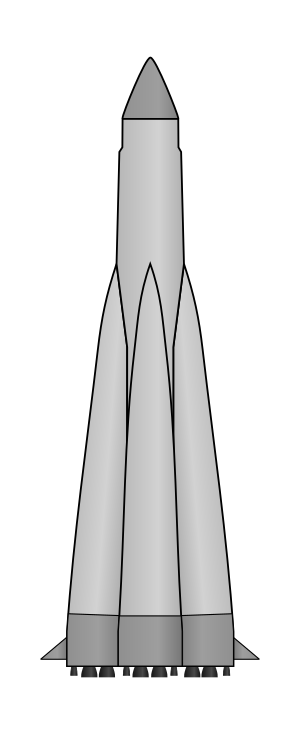Polyot (rocket)
This article needs additional citations for verification. (December 2009) |
 Polyot rocket | |
| Function | Interim carrier rocket |
|---|---|
| P176 | OKB-1 |
| P495 | Soviet Union |
| Size | |
| P2048 | 30 m (98 ft) |
| P2386 | 2.99 m (9 ft 10 in) |
| P2067 | 277,000 kg (611,000 lb) |
| Stages | 1 |
| Capacity | |
| Payload to LEO | |
| P2067 | 1,400 kg (3,100 lb) |
| Associated rockets | |
| Family | R-7 |
| Launch history | |
| Status | Retired |
| Launch sites | LC-31, Baikonur |
| Total launches | 2 |
| Success(es) | 2 |
| First flight | 1 November 1963 |
| Last flight | 12 April 1964 |
| Boosters | |
| No. boosters | 4 |
| P516 | 4 RD-107-8D74K |
| P2228 | 995.3 kN (223,800 lbf) |
| Specific impulse | 257 s (2.52 km/s) |
| Burn time | 119 seconds |
| Propellant | RP-1/LOX |
| First stage | |
| P516 | 1 RD-0108 |
| P2228 | 294 kN (66,000 lbf) |
| Specific impulse | 330 s (3.2 km/s) |
| Burn time | 240 seconds |
| Propellant | RP-1/LOX |
The Polyot (‹See Tfd›Russian: Полёт, flight) (Also known as Sputnik, GRAU index 11A59) was an interim orbital carrier rocket, built to test ASAT spacecraft. It was required as a stopgap after the cancellation of the UR-200 programme, but before the Tsyklon could enter service. Only two were ever launched, the first on 1 November 1963, and the last on 12 April 1964. Both of these flights were successful.
The rocket consisted of a core stage, and four boosters, which were taken from a Voskhod 11A57 rocket. It was capable of delivering a 1,400 kg payload into a 300 km by 59° Low Earth orbit.
It is a member of the R-7 family.
See also
Comparable rockets
Related developments
Associated spacecraft
External links
